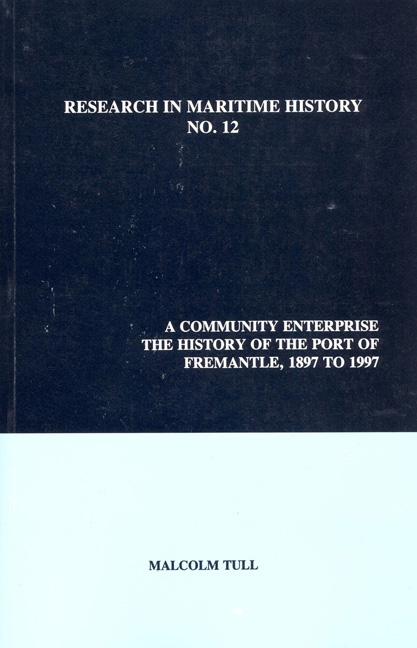Book contents
- Frontmatter
- Table of Contents
- List of Tables
- List of Figures
- List of Photos
- Acknowledgements
- Abbreviations
- Conversions
- Introduction
- Chapter 1 The Birth of A Modern Port
- Chapter 2 The Establishment of The Fremantle Harbour Trust
- Chapter 3 The Development Of Trade At The Port of Fremantle
- Chapter 4 The Shipping of Fremantle
- Chapter 5 A Century of Port Development, 1897 To 1997
- Chapter 6 Cargo-Handling Technology, Working Conditions And Industrial Relations on The Fremantle Waterfront
- Chapter 7 From Port Authority To Strategic Manager: The Transformation of The FPA
- Appendix A Trade and Shipping Statistics
- Appendix B Financial Statistics
- Appendix C Labour Statistics
- Appendix D
- Bibliography
- Index
Chapter 5 - A Century of Port Development, 1897 To 1997
- Frontmatter
- Table of Contents
- List of Tables
- List of Figures
- List of Photos
- Acknowledgements
- Abbreviations
- Conversions
- Introduction
- Chapter 1 The Birth of A Modern Port
- Chapter 2 The Establishment of The Fremantle Harbour Trust
- Chapter 3 The Development Of Trade At The Port of Fremantle
- Chapter 4 The Shipping of Fremantle
- Chapter 5 A Century of Port Development, 1897 To 1997
- Chapter 6 Cargo-Handling Technology, Working Conditions And Industrial Relations on The Fremantle Waterfront
- Chapter 7 From Port Authority To Strategic Manager: The Transformation of The FPA
- Appendix A Trade and Shipping Statistics
- Appendix B Financial Statistics
- Appendix C Labour Statistics
- Appendix D
- Bibliography
- Index
Summary
In chapters 3 and 4 we examined the growth and changing composition of port activity at Fremantle between the 1890s and 1990s. The volume of cargo grew from about 0.7 million tons in 1903-1904 to 20.2 million tons in 1995-1996; over the same period shipping tonnage increased from 1.4 million tons to 33.5 million tons and passenger movements dropped from about 46,000 to less than 10,000. Fremantle was called on to make provision for a wide range of cargoes and ship types. Passenger liners, tankers and bulk carriers, in particular, placed heavy demands on the port for increased depths and rapid turnround. The objective of this chapter is to trace the physical evolution of the port in response to these demands.
The changes to the port were the outcome of a complex process of decision-making and adjustment in which a large number of actors played a part, amongst whom the most important were the Fremantle Harbour Trust (renamed the Fremantle Port Authority in 1964), government, shipowners and consignees. Moreover, in Western Australia's small community the port served as a visible symbol of progress, and plans for port development were a matter of widespread public discussion and debate. Over the years a number of “battles” occurred over the appropriate port facilities and their locations - “battles” which even a succession of “expert” reports failed to completely resolve. As we will see, Fremantle's development (or non-development) in consequence was not merely a mechanical response to trends in trade and shipping; it was the result of a complex interaction between a multitude of social, political and economic influences.
We commence with a schematic, bird's-eye view of the physical growth of Fremantle, based on J. Bird's “Anyport” model. A brief discussion of the advantages and (limited) disadvantages of C.Y. O'Connor's port follows this. We next chart the major endeavours to make Fremantle a “first class port:” the provision of increased depth of water; the ill-fated dock; the battle of the plans in the 1920s; the development of bulk grain handling in the 1930s; Tydeman's plan for post-Second World War port development and how it was constrained by metropolitan landuse activities; the development of the Outer Harbour and containerisation. Finally, we consider the issues affecting the survival of the Inner Harbour as a commercial port over the next century.
- Type
- Chapter
- Information
- A Community EnterpriseThe History of the Port of Fremantle, 1897 to 1997, pp. 151 - 200Publisher: Liverpool University PressPrint publication year: 1997

